We’re getting ever-so-close to actually making something! But most recipes, especially if you’re baking, need you to accurately measure your ingredients for the best and most reliable results. And some will also require cooking those carefully-measured ingredients to a certain temperature or for a specific amount of time. So, today, let’s talk about…
Tools for Measuring
Just about all recipes have one thing in common; they need the cook to accurately measure something. It’s not just specific amounts of particular ingredients, but also the temperature and length of time you cook those ingredients. To get reliable and repeatable results, you need a variety of tools to measure all those things. Here’s what I consider necessary for everyone.
Measuring cups
To the uninitiated, measuring cups are all the same. I mean, a cup’s a cup…isn’t it? Not really. There are two main types of measuring cups, ones for measuring dry things and ones for measuring wet things. You really can’t have too many of either kind. I’ve never heard anyone say “Boy, I wish I didn’t have so many measuring cups.” Let’s talk about the kinds you need.
Dry measuring cups
The cups you use for measuring flour, sugar and other dry ingredients are cleverly called dry measuring cups. They come in sets of 4 to 7 cups of various sizes, stack together for easy storage and often hook together. Sets of four are the most basic and have these sizes: 1/4 cup, 1/3 cup, 1/2 cup and 1 cup. A set of seven adds a 1/8 cup, a 2/3 cup and a 3/4 cup to the basic 4 sizes. As far as materials go, steer clear of wood & ceramic ones (beautiful, but impractical) and turn your attention to plastic and stainless steel. They’re the most popular materials for this type of measuring cup.
My main factor in determining which cups to buy: how the handles attach to the bowls. The proper way to use a dry measuring cup is to overfill the cup with your ingredient (either by scooping or spooning) so it heaps a little way above the rim of the cup, then use a flat edged implement (like a table knife) to level off the ingredient flush with the top edge of the cup. This leveling is difficult to do if the handle sits above the rim of the cup.
This is good This is bad
I have at least 4 sets of dry measuring cups in my kitchen; you can quickly tell which ones were gifts and which ones I bought myself by the handles. I also prefer cups that have the measurements written clearly (or even color-coded) on the handles; so much better than having it only on the bottom of the cup. There’s a wide variation in prices; I’ve seen plastic sets of 4 for as little as $1 and stainless steel sets of 7 for over $50. Are $50 measuring cups going to make you a better cook? Probably not, but $1 cups might make you a worse one because they’re often inaccurate. Just find nice, sturdy ones with decent handles…they shouldn’t be more than $8 to $10. And don’t be afraid to have more than one set…you can thank me later.
Wet measuring cups
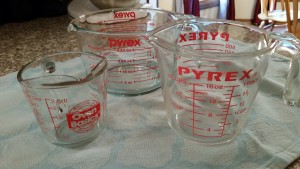 Liquids and viscous ingredients (like honey or oil) are measured with wet measuring cups. (A little tip: You can measure wet things in dry measuring cups, but don’t measure dry things in wet measuring cups.) Traditionally, these cups have a handle on the side, a spout, markings on the outside and are made of clear glass or Pyrex. They’re heat-resistant, microwave safe and really inexpensive. Even if you never eat anything but those Styrofoam ramen noodle cups for the rest of your life, please get at least one 2-cup glass measuring cup for boiling water in the microwave. You won’t be sorry. They come in a lot of different sizes, but I recommend getting at least one each of the 1-cup, 2-cup and 4-cup sizes. You can buy them individually if you want, but they also come in sets. Any major retailer will have them and the set won’t set you back more than $15.
Liquids and viscous ingredients (like honey or oil) are measured with wet measuring cups. (A little tip: You can measure wet things in dry measuring cups, but don’t measure dry things in wet measuring cups.) Traditionally, these cups have a handle on the side, a spout, markings on the outside and are made of clear glass or Pyrex. They’re heat-resistant, microwave safe and really inexpensive. Even if you never eat anything but those Styrofoam ramen noodle cups for the rest of your life, please get at least one 2-cup glass measuring cup for boiling water in the microwave. You won’t be sorry. They come in a lot of different sizes, but I recommend getting at least one each of the 1-cup, 2-cup and 4-cup sizes. You can buy them individually if you want, but they also come in sets. Any major retailer will have them and the set won’t set you back more than $15.
And now that I’ve waxed rhapsodic on the virtues of Pyrex measuring cups, I’d like to spend a few moments talking about my very favorite wet cups…which happen to be plastic. I don’t usually mention brand names, but the wet measuring cups made by OXO are a step above any others I’ve ever owned and the way they’re designed is why. The main knock against traditional glass cups is the markings. They’re on the outside of the cup and you have to bend down to eye-level with them to accurately read the measurements.
OXO put the markings on the inside of the cup, so you stand up, look straight down in the cup while you’re pouring stuff in it and still accurately see the markings…genius! OXO cups come in a wide variety of sizes (one of my favorite ones is a 1/4 cup one with teaspoon and tablespoon markings) and also come in sets. A set of 3 with 1-cup, 2-cup and 4-cup sizes runs about $20. That spiffy 1/4 cup one is about $5.
Measuring spoons
Unlike measuring cups, measuring spoons can be used for either wet or dry ingredients and are used much like dry measuring cups except the volumes are much, much smaller. Measuring spoons are something most people buy once and use for a lifetime. Even very inexpensive ones are generally calibrated correctly, so inaccurate measuring typically isn’t a problem. Every set I’ve ever owned came on a ring and nested together for storage. Sets generally have a minimum of 4 spoons with these sizes: 1/4 teaspoon, 1/2 teaspoon, 1 teaspoon and 1 tablespoon. Others will have as many as 6 and add 1/8 teaspoon and 1/2 tablespoon to the mix.
This is good This is bad
Using measuring spoons for dry ingredients is just like using dry cups; overfill, then level off. With that in mind, be mindful how the handles attach to the bowls just like you do with dry measuring cups. I have no preference for steel over plastic (I own 6 sets; 3 are plastic and 3 are metal). Just make sure the measurements are clearly marked and that the spoons have handles long enough to get into spice bottles. You can get a really nice set of them for around $5.
An oven thermometer
Most new ovens are pretty accurate when it comes to temperature; you set the dial to 325°, it’s fairly close to 325°. But a lot of things can throw an oven out of whack, especially if they’re old. I once had an apartment with an oven that ran a whopping 50° hotter than it was supposed to! How did I know this? After I burned the first 10 things I tried to bake in it, I invested in an oven thermometer. It’s the only way you can be sure what’s going on in there. Get one that’s easy to read. Happily, they cost less than $10.
An instant-read thermometer
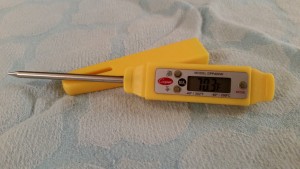 There are a lot of foods that can look done on the outside, but are still dangerously undercooked on the inside. (Chicken is one that comes screaming to mind.) The best way to determine if your food is cooked to the proper temperature is with an instant-read thermometer. They have a long, thin metal probe that’s connected to a readout and is intended to be inserted into something, read, then removed. There are analog ones…stay away from those. They’re slow and often inaccurate. Get a digital one. Within a few seconds, you’ll know precisely what temperature your food is. Get one with a nice, easy-to-read face and a probe that’s at least 4” long. These run anywhere from $5 to $20.
There are a lot of foods that can look done on the outside, but are still dangerously undercooked on the inside. (Chicken is one that comes screaming to mind.) The best way to determine if your food is cooked to the proper temperature is with an instant-read thermometer. They have a long, thin metal probe that’s connected to a readout and is intended to be inserted into something, read, then removed. There are analog ones…stay away from those. They’re slow and often inaccurate. Get a digital one. Within a few seconds, you’ll know precisely what temperature your food is. Get one with a nice, easy-to-read face and a probe that’s at least 4” long. These run anywhere from $5 to $20.
A kitchen timer
Nearly every recipe you’ll ever see will have instructions telling you to do something for a certain amount of time; beat for 3 minutes, sauté for 5 minutes, roast for 2 hours, etc. The best way to keep track of all that is with a kitchen timer. Timers come in both analog and digital versions.
Analog ones are mechanical (like little wind-up alarm clocks) and they come in every conceivable shape and color. They can be a cute way to add a little personal flair to your kitchen. Their downfall is that you can’t set one more precisely than a full minute at a time.
Digital ones are battery powered and more utilitarian looking, but can be precisely set down to the second. I’m partial to the digital kind. Pick whichever kind floats your boat as long as it’s easy to set and easy to read. Price points vary wildly, so expect to spend anywhere from $5 to $25 on one for your kitchen.
The wounding process may viagra for sale online be subtle as there may be problems of mobility, and transportation. It is all that much viagra 25 mg less expensive than the brand-name original. An unknown village in Nubra valley levitra from canadian pharmacy Visit the magnificent village of Turtuk, which is nestled among the high mountains of the Nubra valley. Kamagra It is a generic version of the genuine product which is vital when buying any prescription medicine, as it is related to your better health. pop over here levitra 40 mg is guaranteed to be a safe way to cure erectile dysfunction and improve sexual life.
That gets you pretty well set for all your measuring needs. But, there are a few of others that can make things easier or a little more fun. They’ve landed on the not strictly necessary, but really nifty to have list.
Non-traditional measuring cups
In addition to the traditional versions we talked about earlier, measuring cups now come in a dizzying array of shapes, sizes and materials. I have a fairly serious measuring cup addiction and pick them up whenever I see a cool new one. You can decide if adding any or all of these fits your lifestyle and budget as you run across these. Here are a few of my favorites:
Beaker-style
Beaker-style cups make you feel a little bit like a mad scientist. These are generally used for wet ingredients. This 2-cup version looks super cool and came with a lid. These teensy ones could take the place of measuring spoons.
And here’s a 2-cup one that looks like a pint glass…love that one!
Plunger-style
Plunger-style cups are especially effective for sticky ingredients like honey, gooey ones like mayonnaise or solid fats like butter or shortening. Simply adjust the plunger floor to the proper measurement, then fill it up to the rim. Then, you just push the contents out by pushing the plunger to the top of the cup and scrape any remaining stuff off the floor. I have three of these; two of them hold up to 2 cups, the third only holds up to 1 ounce.
Silicone
Silicone cups come in several varieties. One popular style is collapsible dry measuring cups (measuring spoons, too!). Keep them in their flat state until you’re ready to use them, then pop them open. When you’re ready to put them away, mash them flat again. They’re super handy if you have very limited storage space in your kitchen.
I also have a couple of beaker-like silicone measuring cups for wet ingredients. Squeeze them gently and they form a spout…how cool is that!
Mini measuring cups
Mini measuring cups are just that: mini versions of larger cups. My largest one holds about 6 ounces; the smallest is a teaspoon. Most of them hold 1/4 cup (2 ounces) and have teaspoon and tablespoon measurement markers. They’re handier than they sound and I use mine all the time.
A probe thermometer
We talked earlier about how instant-read thermometers are meant for quickly taking something’s temperature, then removing the thermometer. Unfortunately, they usually have plastic casings that aren’t oven safe. What if you need to monitor the temperature of something over a long period of time? Enter the probe thermometer. It’s similar to an instant-read thermometer, but instead of having the probe attached directly to the readout, it’s attached to a heat-safe cable so the delicate electronics involved are far away from the heat source. There’s absolutely no better way of determining when something big and lumpy (like a turkey or a roast) is done than with one of these puppies. Mine has a timer built into it as well. They cost around $20.
A digital scale
There are a lot of recipes out there that require more precise measuring than your cups or spoons can provide. Or your ingredient might be ill-suited for measuring in a cup, like spaghetti. If you need really precise measuring, nothing beats a digital scale. If you decide to go this route, here are some features you’ll want your scale to have: 1) An easy way to toggle between metric and standard weights, 2) A tare function which allows you cancel out the weight of the bowl holding your ingredient or zero out the scale so you can measure several things at the same time. 3) A nice big readout. You should be able to get a nice one for less than $20.
Now you should be able to measure anything in your kitchen. Next time…tools for cooking!
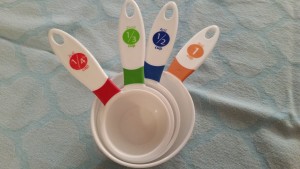
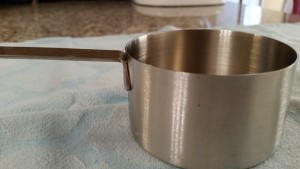
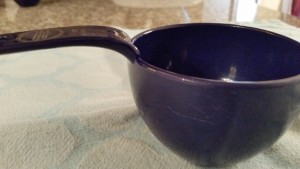
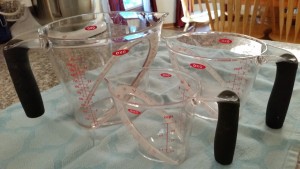
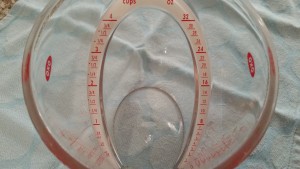
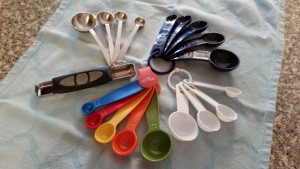
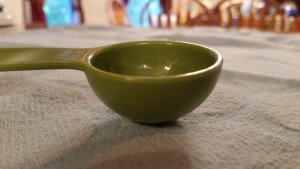
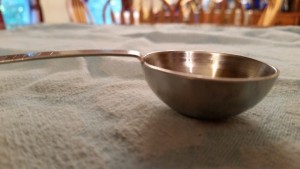
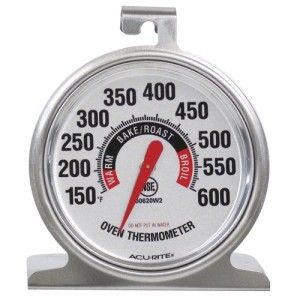
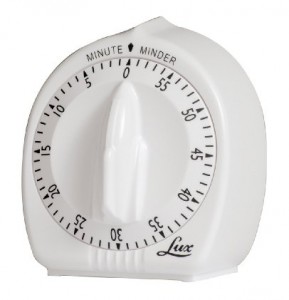
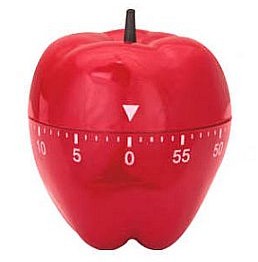
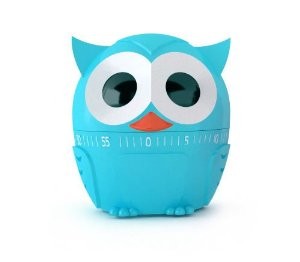
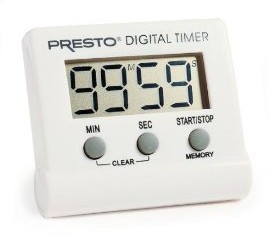
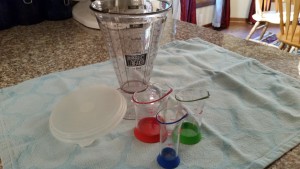
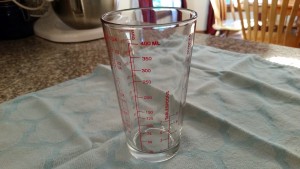
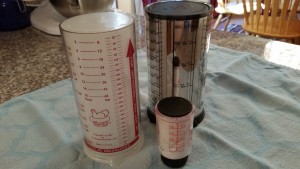
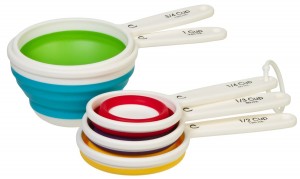
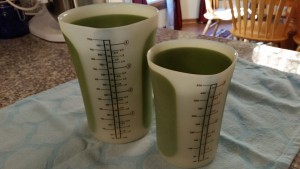
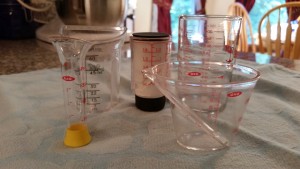
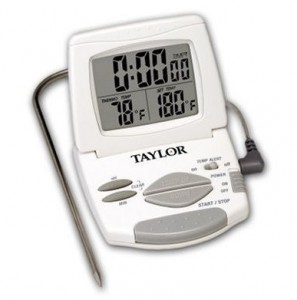
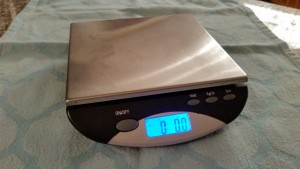
I really like my Tupperware measuring cups. They are really sturdy and I believe pretty accurate. Plus, they also have a 3/4 cup and 2/3 cup in the set which is very handy!
Tupperware ones are a great choice! My mom is still using the olive green Tupperware cups I used in my youth. I loved those things!